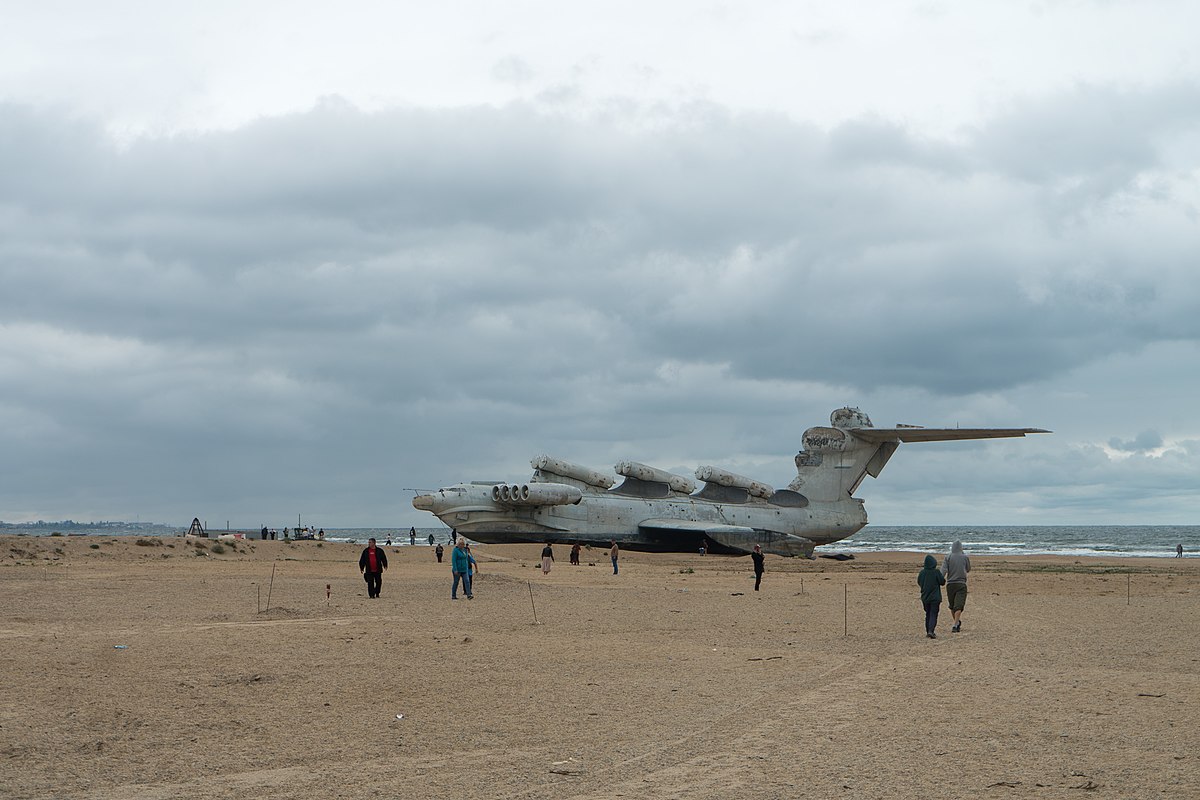
Photo: Alexey Komarov | Wikimedia Commons
Caspian Sea Monster. Photo Credit: RedditA length of 92 meters. A wingspan of 37.6 meters. As many as eight engines in its bilaterally symmetrical body. A wingship. A flarecraft. Something as bulky as 240,000 kilograms. Something that was quietly perched above the surface of the waters but not as much as your typical aircraft. As the largest aircraft when it was finished in 1966, the Caspian Sea Monster was a fright for many until it retired in 1980.
Its history traces to when the US and the Soviet Union were at loggerheads with one another after the World War until the dissolution of the USSR into Russia. The Cold War that they fought was fraught with technical innovation ranging from missions to space, orbiters to planets, and on the not-so-distant skies of the earth- in aviation. Caspian Sea Monster was one marvelous product of the two countries pushing each other for technical supremacy.
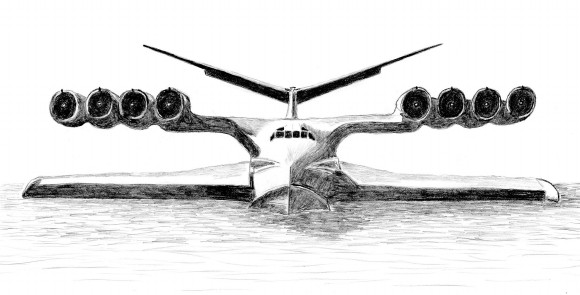
This ground-effect vehicle was a veritable bridge- something that helped connect the conceptual designs of aircraft, watercraft, and land craft. Its monstrous design, four thrusters located on either side of its symmetrical body, and a staggering look from a top view gave it a rather mythical name: “Caspian Sea Monster.”
Caspian Sea Monster was designed for use by the military and first responders. Designed by the USSR, it was to travel at a lightning pace whilst being poised just 5 and 10 meters above sea level. In this guide, we’ll take a look at the forces that shaped the aircraft, how it operated, and its other comprehensive features.

Photo: A.Morgunovskaya | Wikimedia Commons
A Few Interesting Facts about the Caspian Sea Monster
- The Caspian Sea Monster was an Ekranoplan, i.e., a ground-effect vehicle. A ground-effect vehicle typically operates with the help of the interplay of aerodynamics between the wing and the surface below.
- Its development by the Soviet Union’s Central Hydrofoil Design Bureau (TsKB-206) took place as early as 1964, and its first flight took off in 1966.
- The Caspian Sea Monster earned its ghoulish name because of its impressive wingspan of around 40 meters (131 feet) and length of over 90 meters (295 feet).
- It had a maximum takeoff weight of 544,000 kilograms.
- The ground effect phenomenon helps generate lift when flying close to the ground or water surface, making way for high speeds while remaining relatively close to the surface.
- Due to its low-altitude flight, the Caspian Sea Monster was undetectable to many radar systems.
- These engines of Caspian Sea Monster, which added up to 8, were mounted on top of the aircraft’s wing structure, giving it the necessary thrust.
- Its intended purpose was to serve as a military transport vehicle capable of delivering troops and equipment over long distances at high speeds.
- The Caspian Sea Monster had a maximum speed of approximately 500 km/h (310 mph) and a range of around 1,500 kilometers (930 miles).
- Due to the engineering and technological challenges it faced, it never entered mass production.
- It did push the boundaries of aircraft design, though, and helped advance ground-effect vehicle technology.
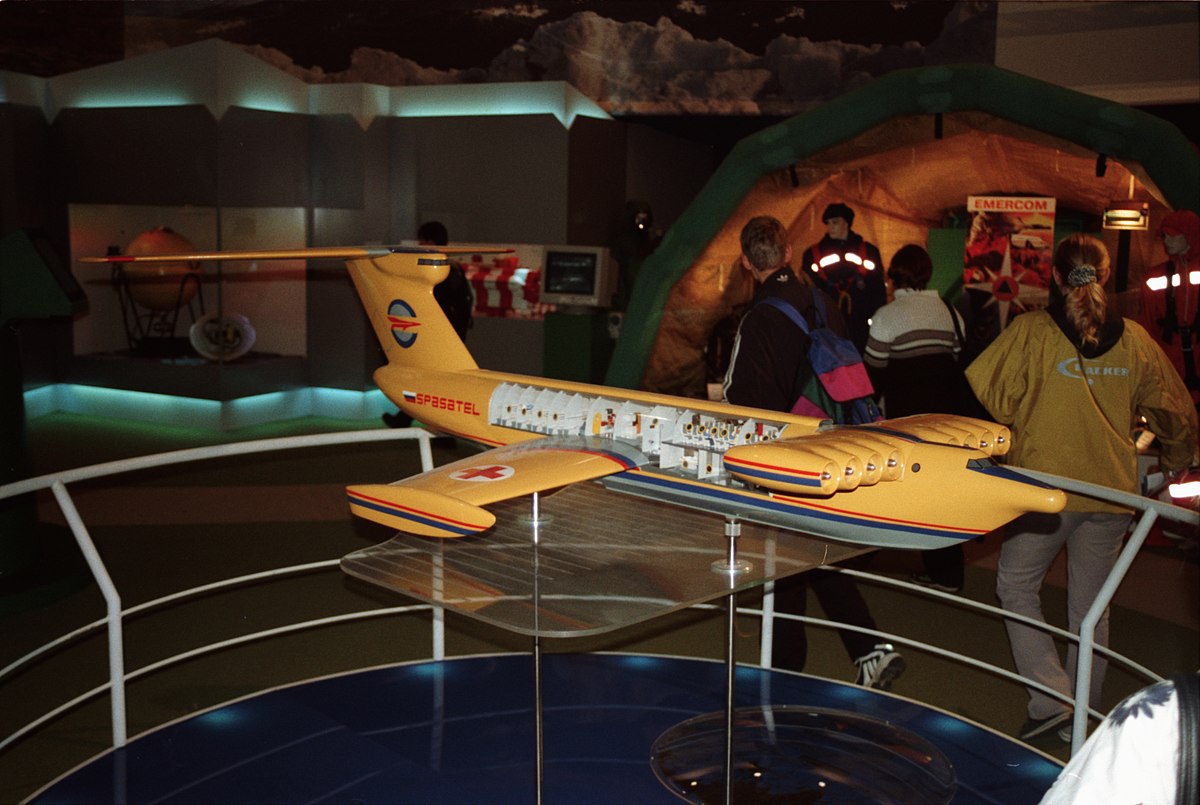
Photo: Bassaar | Wikimedia Commons
Background of Korabl Market, aka Caspian Sea Monster
The Central Hydrofoil Design Bureau of the USSR, which is now known as Alekseyev Central Hydrofoil Design Bureau, created the enormous experimental Ekranoplan known as Korabl Maket in the 1960s.
The word “Korabl Market” means a “prototype ship,” while the word “Ekranoplan” has Russian origins with the meaning “screen glider,” although more commonly, it refers to any type of vehicle that hovers above the ground, mimics gliding and uses the ground- effect technology for its motion.
With plans of construction unveiled in 1964, the Caspian Sea Monster’s construction was finished by June 1966 and took off for the first time that very year on October 16.

It is widely known now that the Caspian Sea Monster was kept a secret for close to 15 years. And when the US did discover this vessel that was first designed to be naval, they were taken aback. The rest of the world got to know about the Caspian Sea Monster after a US spy satellite that was orbiting the Soviet naval facility in the late 1960s captured images of this more unusual aircraft with short, square wings. A staggering length of more than 100 meters, perched atop the Caspian Sea coast, led the US to dub this leviathan “Caspian Sea Monster”.
Development of the KM
Outdoing the other nations in technology during the World War was what led to the fruition of the Caspian Sea Monster. In addition to being shielded from the radar of other countries, an ekranoplan was also immune to torpedoes, anti-submarine nets, and mines too.
Rostislav Evgenievich Alexeyev, after whom the Alekseyev Central Hydrofoil Design Bureau, aka Central Hydrofoil Design Bureau, was named, was the chief investigative officer behind the design of the Caspian Sea Monster. After the completion of the construction of its prototype in 1966, the KM was shipped, albeit surreptitiously, to Kaspiysk, a city in the Republic of Dagestan.
The journey to Kaspiysk was made along the Volga River. Its test flight was co-piloted by Rostistav Alexeyev himself. Rostistav Alexeyev, who died later in 1980 as he was testing a new ekranoplan for the 1980 Summer Olympics, was what one might call a one-of-a-kind person. This is because Russian designers usually didn’t test their creations.

Photo: Alexey Komarov | Wikimedia Commons
Working principle and design of the Caspian Sea Monster
Although the Caspian Sea Monster was technically an aircraft, some might be hesitant to deem it so. This is because it doesn’t quite achieve the heights that a modern aircraft does. While a modern aircraft might be cruising at an altitude of thousands of feet, the Km inched only a few meters to ten meters above the water/ground surface. So it has been described as a “half-boat half-plane”.
Ekranoplans are classified as ships by the International Maritime Organization. This is because they are designed so as to glide over a flat surface. But their functioning, in particular the takeoff and flight of a few meters over the surface, necessitates these craft to be well-equipped with special speed capabilities across the water.
KM manages to fly as it makes use of what is known in aerodynamic theory as the “ground effect.” An ekranoplan flies over flatter surfaces, especially water bodies, without really touching them. In doing so, it is facilitated by the responses it gets from and of the air. The aircraft wing experiences a reduced drag the closer it operates to a flat surface. When the airplane is close to the ground, the air cushion accumulates beneath the wings and provides the necessary lift force.
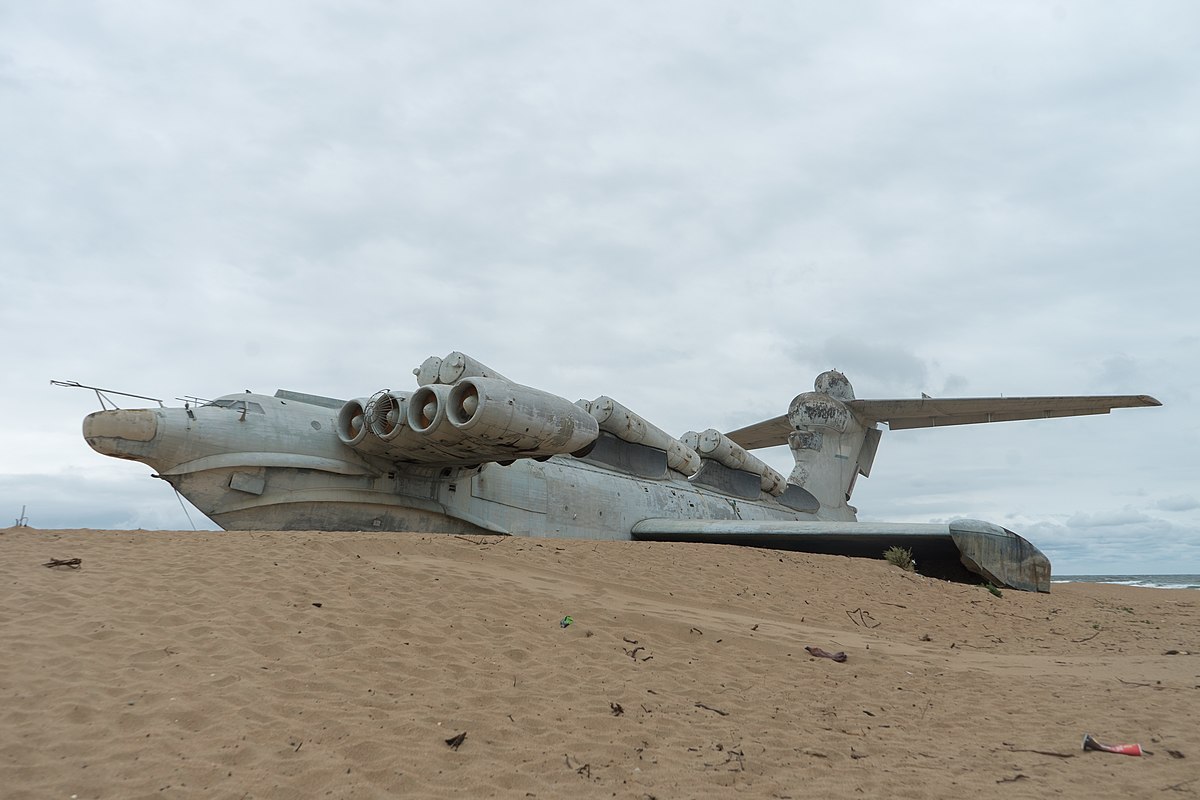
The Ekranoplan held much promise for the Soviets as the staggering Maximum takeoff weight of 540,000 kg would allow many soldiers to travel as quickly as a jet without being detected by an enemy’s radar system. Its speed, coupled with its stealth, was to be their great advantage- also allowing for the possibility to use the Caspian Sea Monster as a useful cargo vessel.
The eventual fate of the Caspian Sea Monster
Throughout the one-and-a-half decade operations, the Soviet Air Force test pilots continued to test the Caspian Sea Monster on the very sea that gives it its rather monsterish name: the Caspian Sea. However, the KM’s intricate design prevented it from being a highly efficient military transport vehicle. Perhaps this realization dawned on the designer Alexeyev, who rapidly turned his focus to other ekranoplan ideas.
The enormous Caspian Sea Monster, only one of which has ever been made, crashed in 1980. No person was injured during the crash. It is often reported that an inexperienced pilot botched the operation of the throttles causing it to initially float, but without any missions to recover it, eventually, sink inside the waters of the Caspian Sea.
The Legacy of the Caspian Sea Monster: the Lun-class Ekranoplan
The experimental aircraft, the Caspian Sea Monster, served as the inspiration for the development of Lun-class ekranoplan. These veritable ships, which couldn’t be classified either as airplanes or seaplanes or hovercraft or hydrofoils, were used as warship. Alexeyev mastered the design of the ‘Lun’ class Ekranoplan in 1975, which went into service in 1987 and made it past the Soviet era.

This Lun-class ekranoplan was accepted into service as an attack/transport ground effect vehicle by the Soviet Navy Caspian Flotilla in 1987. The only completed Lun-Class ekranoplan was the MD-160, which weighed 380 tons and could fly at the speed of 550 km/h. Its eight Kuznetsov NK-87 turbofans gave it a range of 2,000-kilometer range whilst its cruise speed was 450 kilometers per hour.
In order to draw a contrast with other aircraft, the striking “Lun” ekranoplan was longer than an Airbus A380 superjumbo. It could accommodate 15 crew members and transport 137 tonnes of Cargo. Six enormous guided missile launchers perched atop the hull of the Ekranoplan added to the impressive weight of the Lun, which was 380 tons.
The iconic aircraft, with its myriad of practical faults and inefficiency, was decommissioned and abandoned at Kaspiysk Naval Base. After the fall of the Soviet Union, the only completed MD-160 of its type was largely left unattended for more than three decades on a distant military pier in the water until the year 2020.
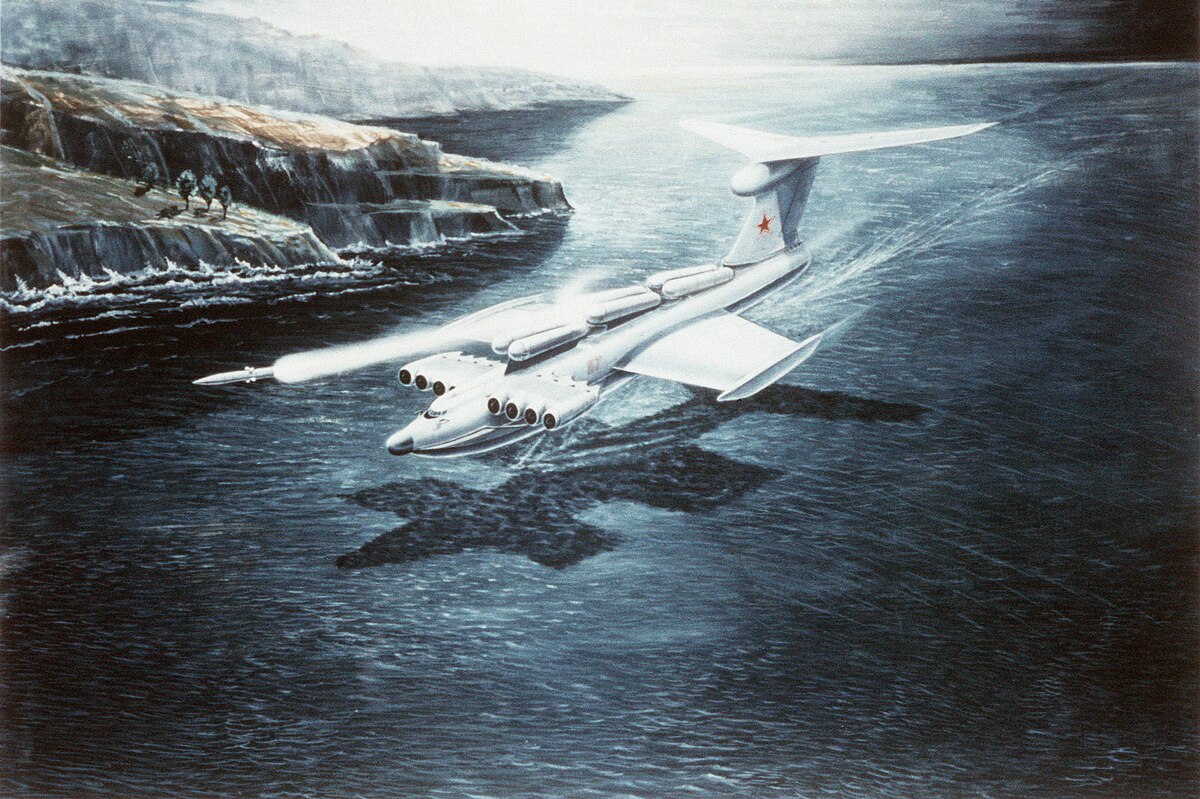
Photo: Uncredited Defense Intelligence Agency artist | Wikimedia Commons
Russian authorities removed this storied military aircraft from the Kaspiysk naval facility on July 31, 2020. The Ekranoplan was hauled ashore and transported to its final location, where it will be installed at a nearby nautical museum.
What about the second Lun-class ekranoplan?
Only one, i.e., MD-160, of the two Lun-class ekranoplans that were planned to be produced ever saw completion. This class of Ekranoplan was designed to be unarmed and used for supply and rescue missions. The construction was completed in the latter half of the 1980s. There was a dearth of finances for the development of the second of the proposed Ekranoplan after the Soviet Union fell apart. This was because the military fund apportioned for the development of Ekranoplan was cut short.
There was also a primary defect in the Lun-class ekranoplan that saw them being disbanded. This was because for them to operate over the sea effectively, the sea had to be completely calm. The operations of the Ekranoplan, only a few meters above the sea, coupled with the short wingspan, meant that even mildly rough seas were capable of putting the Ekranoplan out of balance.

Photo: Fblockmetal | Wikimedia Commons
The Caspian Sea Monster Rising From the Dead
A flotilla that comprised three tugs and two escort vehicles was able to drag, albeit lugubriously, the Caspian Sea Monster front the dregs of the Caspian Sea, where it was abandoned to the shores of the city of Derbent. It was likely put there to not let the monster fade into oblivion but to live in the memories of tourists by making it an attraction.
Had the Caspian Sea Monster not been reduced it was doomed to rust away in the naval base of Russia at Kaspiysk, which lies around 62 miles from the city where it is currently housed.
The Ekranoplan is, as some newspapers reported, beached. This means that it is still waiting for a structure to be built where it can be safely placed. The fact that the city where it is located i.e. Derbent is the oldest continuously settled area in Russia and a UNESCO World Heritage Site means that the Ekranoplan won’t have a dearth of visitors too.
